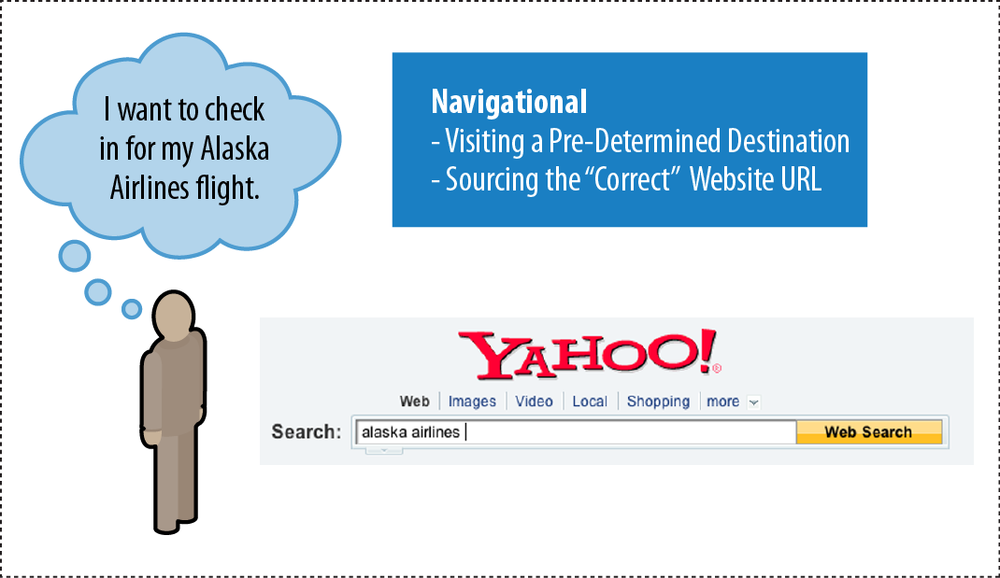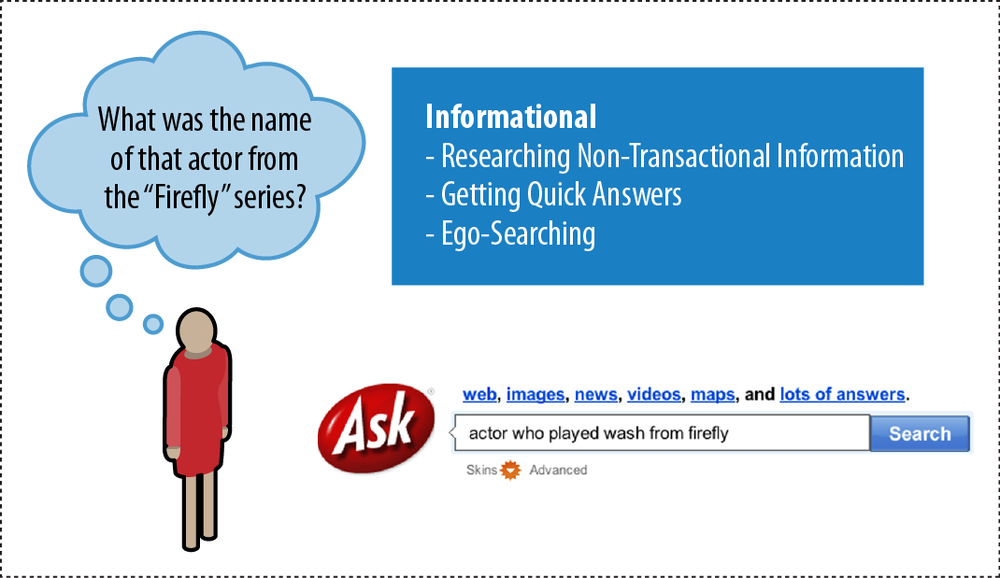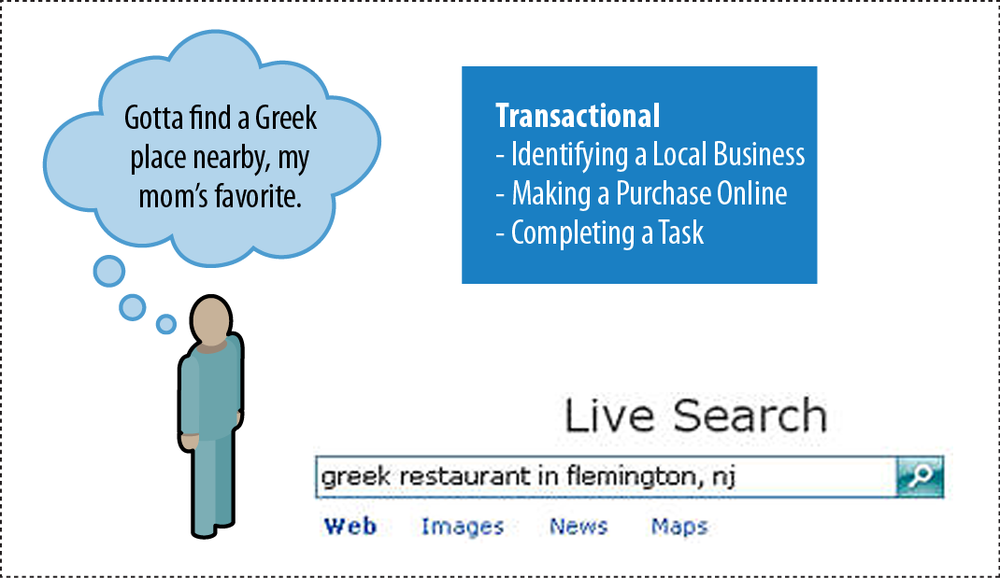Good marketers are empathetic. Smart SEO practitioners and the search engines have a common goal of providing searchers with results that are relevant to their queries. Therefore, a crucial element to building an online marketing strategy around SEO and search rankings is understanding your audience. Once you grasp how your target market searches for your service, product, or resource, you can more effectively reach and keep those users.
Search engine marketers need to be aware that search engines are tools—resources driven by intent. Using the search box is fundamentally different from entering a URL into the browser’s address bar, clicking on a bookmark, or picking a link on your start page to go to a website; it is not the same as a click on the “stumble” button in your StumbleUpon toolbar or a visit to your favorite blog. Searches are performed with intent; the user wants to find something in particular, rather than just land on it by happenstance.
What follows is an examination of the different types of queries, their categories, characteristics, and processes.
Navigational searches are performed with the intent of surfing directly to a specific website. In some cases, the user may not know the exact URL, and the search engine serves as the “White Pages.” Figure 1-2 shows an example of a navigational query.
Opportunities: Pull searcher away from destination; get ancillary or investigatory traffic.
Average traffic value: Very high when searches are for the publisher’s own brand. These types of searches tend to lead to very high conversion rates. However, these searchers are already aware of the company brand, so they may not represent new customers. For brands other than the one being searched on, the click-through rates will tend to be low, but this may represent an opportunity to take a customer away from a competitor.
Informational searches involve a huge range of queries—for example, local weather, maps and directions, details on the latest Hollywood awards ceremony, or just checking how long that trip to Mars really takes. Informational searches are primarily non-transaction-oriented (although they can include researching information about a product or service); the information itself is the goal and no interaction beyond clicking and reading is required. Figure 1-3 shows an example of an informational query.
Opportunities: Brand searchers with positive impressions of your site, information, company, and so on; attract inbound links; receive attention from journalists/researchers; potentially convert to sign up or purchase.
Average traffic value: The searcher may not be ready to buy anything as yet, or may not even have a long-term intent to buy anything, so the value tends to be “medium” at best. However, many of these searchers will later enter in a more targeted search, and this represents an opportunity to capture mindshare with those potential customers. For example, informational queries that are focused on researching commercial products or services can have high value.
Transactional searches don’t necessarily involve a credit card or wire transfer. Signing up for a free trial account at CooksIllustrated.com , creating a Gmail account, paying a parking ticket, or finding the best local Mexican restaurant for dinner tonight are all transactional queries. Figure 1-4 shows an example of a transactional query.
Opportunities: Achieve transaction (financial or other).
Average traffic value: Very high.
Research from Pennsylvania State University and the Queensland University of Technology (http://ist.psu.edu/faculty_pages/jjansen/academic/pubs/jansen_user_intent.pdf) shows that more than 80% of searches are informational in nature, and only about 10% of searches are navigational or transactional.
The researchers went further and developed an algorithm to automatically classify searches by query type. When they tested the algorithm, they found that it was able to correctly classify queries 74% of the time. The difficulty in classifying the remaining queries was vague user intent—that is, the queries could have multiple meanings. Here are some URLs that point to additional academic research on this topic:
The search engines also look at sequences of search queries to determine intent. This was confirmed in Eric Enge’s interview with Jack Menzel, Product Management Director for Google Search (http://www.stonetemple.com/how-google-does-personalization-with-jack-menzel/). You can verify this by trying search sequences such as a search on Rome followed by a search on hotels.
Normally, a search on hotels would not include results for hotels in Rome, but when the preceding query was for Rome, some results for hotels in Rome will be included. Keeping track of users’ previous search queries and taking them into account when determining which results to return for a new query—known as adaptive search—is intended to help the search engines get a better sense of a user’s intent. The search engines need to do this with care: excessive changes to the results they return based on recent query history are likely to lead to problems, so usually these types of changes are fairly limited in scope. Nonetheless, it is useful to be aware of the types of sequences of searches that users go through in their quest for information.
When you are building keyword research charts for clients or on your own sites, it can be incredibly valuable to determine the intent of each of your primary keywords. Table 1-3 shows some examples.
Table 1-3. Sample search queries and intent
Term | Queries | Intent | $$ value |
|---|---|---|---|
Beijing Airport | 980 | Nav | Low |
Hotels in Xi’an | 2,644 | Info | Mid |
7-Day China tour package | 127 | Trans | High |
Sichuan jellyfish recipe | 53 | Info | Low |
This type of analysis can help to determine where to place ads and where to concentrate content and links.
Hopefully, this data can help you to think carefully about how to serve different kinds of searchers based on their individual intents, and how to concentrate your efforts in the best possible areas.
Although informational queries are less likely to immediately convert into sales, this does not necessarily mean you should forego pursuing rankings on such queries. If you are able to build a relationship with users who find your site after an informational query, they may be more likely to come to you to make a related purchase at a later date.
One problem is that when most searchers frame their search queries they provide very limited data to the search engine—usually just one to three words. Since most people don’t have a keen understanding of how search engines work, users often provide queries that are too general or that are presented in a way that does not provide the search engine (or the marketer) with what it needs to determine their intent.
General queries are important to most businesses because they often get the brand and site on the searcher’s radar, and this initiates the process of building trust with the user. Over time, the user will move on to more specific searches that are more transactional or navigational in nature.
If, for instance, companies buying pay-per-click (PPC) search ads bought only the high-converting navigational and transactional terms and left the informational ones to competitors, they would lose market share to those competitors. Over the course of several days, a searcher may start with digital cameras, home in on canon g10, and then ultimately buy from the store that showed up in her search for digital cameras and pointed her in the direction of the Canon G10 model.
Given the general nature of how query sessions start, though, determining intent is quite difficult, and it can result in searches being performed where the user does not find what he wants, even after multiple tries. A July 2011 report (http://www.eweek.com/c/a/Search-Engines/Google-Could-Boost-Customer-Satisfaction-Vs-Facebook-ACSI-Report-644343/) found that 83% of Google users and 82% of Bing users were satisfied with their experiences.
While 83% satisfaction is an amazing accomplishment given the complexity of building a search engine, this study still showed that more than 17% of users did not find what they were looking for. As an SEO practitioner, you should be aware that some of the visitors that you succeed in attracting to your site may have arrived for the wrong reasons (i.e., they were really looking for something else), and these visitors are not likely to help your business goals. Part of your task as an SEO is to maintain a high level of relevance in the content placed on the pages you manage, to help minimize this level of waste.
Get The Art of SEO, 2nd Edition now with the O’Reilly learning platform.
O’Reilly members experience books, live events, courses curated by job role, and more from O’Reilly and nearly 200 top publishers.




